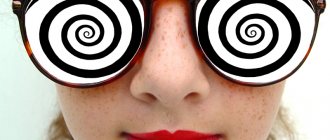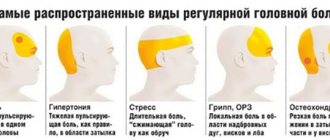Human anatomy and physiology - I. V. Gaivoronsky
14.3. Brain
The brain, encephalon, is the highest division of the central nervous system.
It contains the brain stem, truncus encephali, the cerebellum, cerebellum, and the cerebrum, cerebrum. In the early stages of development (3rd week of intrauterine development), the brain is represented by the rhomboid, middle and forebrain vesicles. Subsequently, the medulla oblongata and hindbrain develop from the rhombencephalon. The hindbrain includes the pons and cerebellum. The forebrain differentiates into the telencephalon and diencephalon (5th week of intrauterine development).
The brain stem is a phylogenetically ancient part in which structures related to the segmental apparatus of the brain and the subcortical centers of hearing, vision, smell and tactile sensitivity are located. The brain stem includes: the medulla oblongata, the pons and the midbrain. Anatomically and functionally connected to them are 10 pairs of cranial nerves - III-XII, the II pair of cranial nerves - the optic nerve - is connected with the diencephalon, the I pair of cranial nerves - the olfactory nerve - with the terminal brain. The classification and spatial arrangement of brain regions are presented in Table. 14.1 and in Fig. 14.9.
Table 14.1
Classification of brain regions
| Three brain vesicle stage | Five brain vesicle stage | Brain bladder cavity | Divisions of the brain |
| I. Diamond-shaped brain, rhombencephalon | I. Medulla oblongata, medulla oblongata II. Hindbrain, metencephalon | Fourth ventricle, ventriculus quartus | 1. Medulla oblongata |
| 1. Bridge, pons | |||
| 2. Cerebellum, cerebellum | |||
| I. Midbrain, mesencephalon | III. Midbrain, mesencephalon * | Plumbing of the brain, aqueductus cerebri | Midbrain, mesencephalon: a) cerebral peduncles, pedunculi cerebri; b) roof plate (quadrigeminal), lamina tecti |
| III. Forebrain, prosencephalon | IV. Diencephalon | Third ventricle, ventriculus tertius | Diencephalon, diencephalon: a) hypothalamus, hypothalamus; b) thalamic brain, thalamencephalon |
| V. Telencephalon | Lateral ventricles | 1. Hemispheres (cloak), hemispheria cerebri (palium) | |
| 2. Basal nuclei, nuclei basales | |||
| 3. Olfactory brain, rhinencephalon |
Rice. 14.9. Sagittal section of the brain: 1 - medulla oblongata; 2 - olive; 3 - bridge; 4 - midbrain (brain peduncle); 5 - oculomotor nerve; 6 - papillary body; 7 - pituitary gland; 8 - optic chiasm; 9 - vault; 10 - frontal lobe; 11 - groove of the corpus callosum; 12 - corpus callosum; 13 - parietal lobe; 14 - thalamus (visual thalamus); 15 - parieto-occipital groove; 16 - occipital lobe; 17 - calcarine groove; 18 - pineal gland; 19 - cerebellum; 20 - plate of the roof of the midbrain; 21 - fourth ventricle
The structures inside the substance of the brain stem can be roughly divided into three zones:
1) base of the brain stem (corresponds to the ventral surface). It contains descending (efferent) pyramidal tracts, starting from the cortex of the cerebral hemispheres - the corticospinal and corticonuclear tracts. They are responsible for performing precise, pre-thought-out, conscious movements and have an inhibitory effect on the segmental apparatus. When the ventral surface of the brain stem is damaged, central paralysis (paresis) occurs, which is characterized by increased muscle tone (hypertonicity), increased reflexes (hyperreflexia);
2) trunk cover (corresponds to the middle zone). It contains afferent (ascending) tracts, efferent extrapyramidal tracts, starting from the subcortical motor centers. In addition, the tegmentum contains cells and nuclei of the reticular formation, nuclei of the cranial nerves and subcortical motor centers of the extrapyramidal system, which unconditionally regulate muscle tone and provide involuntary movements. When the tectum of the brain stem is damaged, sensory disorders, disturbances in muscle tone, cranial nerve function and vital functions (respiration, vascular tone, cardiac activity) occur;
3) the roof of the brain stem is located dorsal to the cavity of the neural tube. It is represented by integration centers: the cerebellum and the quadrigeminal plate. The cerebellum provides coordination of movements, the integration center of the midbrain provides unconditioned reflex movements in response to strong and unexpected stimuli.
It should be noted that unconscious afferent tracts go from the spinal cord and sensory nuclei of the cranial nerves to the subcortical integration centers (cerebellum, midbrain and diencephalon), and conscious afferent tracts go to the integration centers of the cerebral cortex. From the subcortical integration centers to the motor nuclei of the cranial and spinal nerves of the brain, extrapyramidal efferent tracts are directed (provide unconscious movements), and from the cerebral cortex - efferent pyramidal tracts (provide conscious movements).
Medulla . The medulla oblongata, medulla oblongata, is a continuation of the spinal cord (Fig. 14.10). Its shape resembles a truncated cone, which is why it is called the brain bulb, bulbus cerebri. In connection with this name, disorders of the functions of the medulla oblongata are referred to as bulbar disorders. On the ventral surface of the medulla oblongata there are pyramids, olives and the exit points of four pairs of cranial nerves: XII pair - hypoglossal nerve, n. hypoglossus, - innervates the muscles of the tongue; XI pair - accessory nerve, n. accessorius, - innervates the trapezius and sternocleidomastoid muscles; X pair - vagus nerve, n. vagus, - innervates almost all internal organs; IX pair - glossopharyngeal nerve, n. glossopharyngeus, - innervates the tongue, pharynx and parotid gland.
The pyramids contain descending pyramidal tracts. They begin from the effector cells of the cerebral cortex, carry out conscious (at the request of a person) movements and have an inhibitory effect on the segmental apparatus of the brain stem and spinal cord.
The dorsal surface of the medulla oblongata forms the lower part of the floor of the fourth ventricle (the rhomboid fossa). In the tegmentum of the medulla oblongata there is gray matter - the nuclei of these cranial nerves, the reticular formation, olive nuclei and white matter - the pathways. It should be noted that the XII-XI pairs of cranial nerves have only motor nuclei, while the X-IX pairs have motor, sensory and autonomic nuclei. The reticular formation of the medulla oblongata contains vital centers: respiratory; vasomotor; centers of salivation, swallowing, secretion of gastric, pancreatic, intestinal juices and centers of protective reflexes (vomiting, coughing, sneezing). The olive nuclei are responsible for the unconditioned reflex regulation of muscle tone during vestibular loads. In addition, afferent (ascending) and efferent (descending) extrapyramidal tracts pass inside the medulla oblongata. The latter begin from the subcortical motor centers and are responsible for unconditioned reflex movements and muscle tone.
Rice. 14.10. Ventral surface of the brain stem: 1 - interpeduncular fossa; 2 - cerebral peduncle; 3 - optic tract; 4 - olfactory triangle; 5 - olfactory tract; 6 - optic chiasm; 7 - optic nerve; 8 - funnel; 9 - gray tubercle; 10 - papillary body; 11 - oculomotor nerve; 12 - trochlear nerve; 13, 28 - trigeminal nerve; 14 - facial nerve; 15 - vestibulocochlear nerve; 16 - glossopharyngeal nerve; 17—vagus nerve; 18 - accessory nerve; 19 - hypoglossal nerve; 20 - first spinal nerve; 21 - anterior median fissure; 22 - spinal cord; 23 - intersection of pyramids; 24 - olive; 25 - pyramid; 26 - abducens nerve; 27 - middle cerebellar peduncle
In case of damage to the medulla oblongata, breathing disorders, cardiac activity, vascular tone, and swallowing disorders may occur - bulbar disorders, which can lead to death.
Bridge. The pons, located in the form of a transverse ridge above the medulla oblongata. On its ventral surface, 4 pairs of cranial nerves emerge from the substance of the brain: VIII pair - vestibulocochlear nerve , n. vestibulocochlearis, conducts nerve impulses from the organ of hearing and balance to the brain; VII pair - facial nerve , n. facialis, innervates facial muscles, lacrimal, sublingual and submandibular salivary glands, glands of the palate and nasal cavity, taste buds of the tongue; VI pair - abducens nerve , n. abducens, innervates the lateral rectus muscle of the eyeball; V pair - trigeminal nerve, n. trigeminus, innervates the masticatory muscles, facial skin, eyeball, teeth.
The brain is divided into the basilar part, adjacent to the clivus, and the tegmentum, facing the cerebellum. The conventional boundary between them is the trapezoidal body, which is clearly visible in the section and is formed by the fibers of the nerve cells of the auditory pathway.
In the basilar part there are pyramidal tracts, and in the tegmentum there are extrapyramidal and afferent tracts, and there are also numerous nuclei of these cranial nerves and the reticular formation. In particular, the VIII pair has nuclei of special sensitivity - auditory and vestibular, the VII pair has motor, sensory and parasympathetic nuclei, the VI pair has only motor nuclei, the V pair has motor and sensory nuclei. The dorsal surface of the pons forms the upper part of the floor of the fourth ventricle (the rhomboid fossa). Damage to the bridge is characterized by dysfunction of the V-VIII pairs of cranial nerves and damage to the pathways.
Cerebellum. The cerebellum, cerebellum, is the integration center of balance and statokinetic functions. It consists of a worm and two hemispheres. On the outside of these formations there is a cortex (layered neurocytes), and inside there is white matter and nuclei: jagged, spherical, corky and tent nucleus. Through three pairs of legs it is connected to various parts of the brain: upper - with the midbrain; medium - with a bridge; lower - with the medulla oblongata.
The cerebellum ensures coordination of movements, regulates the tone of antagonist muscles (flexors and extensors; adductors and abductors). Under the influence of the cerebral cortex, the cerebellum ensures the execution of precise, subtle, pre-thought-out movements. If the cerebellum is damaged, the accuracy and direction of movements are impaired, muscle tone changes significantly, an unstable, staggering gait and hand tremors appear.
The cavity of the rhombencephalon is the fourth ventricle, which is filled with cerebrospinal fluid. It is located between the medulla oblongata and the pons on one side and the cerebellum on the other.
Midbrain. The midbrain, mesencephalon, is located anterior to the pons. It consists of a roof plate and cerebral peduncles. The cavity of the midbrain is the cerebral aqueduct (Aqueduct of Sylvius).
The ventral surface of the midbrain is represented by the cerebral peduncles. Between them is the interpeduncular fossa. From the latter comes the third pair of cranial nerves - the oculomotor nerve, n. oculomotorius, which innervates the muscles of the eyeball, the muscle that lifts the upper eyelid, the ciliary muscle and the muscle that constricts the pupil. This nerve has parasympathetic and motor nuclei.
The dorsal surface is represented by the plate of the roof (quadrigeminal), below which the fourth pair of cranial nerves emerges (Fig. 14.11). IV pair - trochlear nerve, n. trochlearis, innervates the superior oblique muscle of the eyeball and has only a motor nucleus.
The roof plate consists of paired upper and lower mounds. The inferior colliculus of the quadrigeminal plate is a subcortical hearing center that unconditionally reflexively regulates muscle tone and movement during strong sound stimulation. The superior colliculi are the subcortical centers of vision, smell and tactile sensitivity. Just like the lower colliculi, they unconditionally reflexively regulate muscle tone and movement under strong light, olfactory and tactile stimulation. In the tegmentum of the midbrain there are subcortical motor integration centers - the red nucleus and the substantia nigra, which provide unconditioned reflex regulation of muscle tone and the adoption of a certain posture.
It should be recalled that the efferent pyramidal tracts to the motor nuclei of the cranial and spinal nerves pass along the ventral surface of the entire brain stem. The efferent extrapyramidal tracts, as well as afferent tracts, are localized in the tegmentum.
Rice. 14.11. Dorsal surface of the brain stem: 1 - pineal gland (turned upward); 2 - superior colliculus of the midbrain; 3 - inferior colliculus of the midbrain; 4 - trochlear nerve; 5 - superior cerebellar peduncle; 6 - inferior cerebellar peduncle; 7 - medulla oblongata; 8 - diamond-shaped fossa; 9 - middle cerebellar peduncle; 10 - thalamus (visual thalamus)
With damage to the midbrain, there is a disturbance in the movements of the eyeball and a lack of response to strong sound, light, olfactory and tactile stimulation. In addition, the pupil's reaction to light may be impaired. The pupils may be excessively narrow (miosis), excessively dilated (mydriasis), or variable in size (anisocoria). Lesions of the roof of the midbrain are characterized by disturbances in posture, sensitivity and muscle tone.
Diencephalon. The diencephalon, diencephalon, is located in front of the midbrain and is largely covered by the cerebral hemispheres. It distinguishes between the hypothalamus and the thalamic brain. The cavity of the diencephalon is the third ventricle.
The ventral surface of the diencephalon is represented by the hypothalamus (subthalamic region). It distinguishes between the anterior, intermediate and posterior hypothalamic regions.
The anterior hypothalamic region is represented by the optic chiasma, chiasma opticum, and the visual tracts, tractus opticus. The second pair of cranial nerves approaches the optic chiasm - the optic nerve, n. opticus. These structures belong to the pathways of the visual analyzer.
In the intermediate hypothalamic region, the hypothalamic region itself, the gray tubercle, the infundibulum and the pituitary gland are distinguished (Fig. 14.12). In the hypothalamic region itself, the highest centers of endocrine and autonomic functions are located. They regulate metabolism, body temperature, blood and intracranial pressure, and maintain a constant internal environment (homeostasis). The hypothalamic region itself continues into the gray tubercle, which gradually narrows and turns into a funnel. The pituitary gland, which is located in the fossa of the sella turcica, is fixed to it. The hypothalamus and pituitary gland regulate the activity of all endocrine glands (thyroid, parathyroid, adrenal glands, reproductive glands, etc.).
The posterior hypothalamic region is formed by the papillary bodies, which serve as the subcortical center of smell.
The dorsal surface of the diencephalon, the thalamic brain, is represented by the paired thalamus (visual thalamus), the transthalamic and suprathalamic regions. Numerous sensory nuclei are concentrated in the visual thalamus, where conscious afferent tracts of all types of sensitivity end. From these nuclei they are sent to the cerebral cortex.
The post-thalamic region is represented by the lateral and medial geniculate bodies, which act, respectively, as the subcortical centers of vision and hearing. From them, impulses are sent to the cerebral cortex to the corresponding cortical centers. The main formation of the suprathalamic region is the endocrine gland - the pineal gland, which regulates biological rhythms and delays premature puberty.
Rice. 14.12. Base of the brain. Places of exit of cranial nerves: I - place of exit of the olfactory nerves; II - optic nerve; III - oculomotor nerve; IV - trochlear nerve; V - trigeminal nerve; VI - abducens nerve; VII - facial nerve; VIII - vestibulocochlear nerve; IX - glossopharyngeal nerve; X - vagus nerve; XI - accessory nerve; XII - hypoglossal nerve; 7 - olfactory bulb; 2 - eyeball; 3 - optic nerve; 4 - visual chiasm; 5 - pituitary gland; 6 - pyramid; 7 - spinal cord; 8 - first spinal nerve; 9 - cerebellum; 10 - olive; 77 - bridge; 12 - cerebral peduncle; 13 - optic tract
When the structures of the diencephalon are damaged, severe endocrine disorders and severe thalamic pain occur.
Finite brain. The telencephalon is the largest section of the brain by volume, the mass of which accounts for more than 80% of all other sections. The telencephalon is represented by the right and left hemispheres, connected to each other by the corpus callosum. The hemispheres cover the diencephalon, midbrain and the upper surface of the cerebellum on top, forming the so-called cloak.
In addition to it, the main parts of the telencephalon also include: the olfactory brain and the basal ganglia. The cavity of the telencephalon is the lateral (lateral) ventricles.
Cerebral hemispheres (cloak). The outside of the hemispheres are covered with gray matter, 2–5 mm thick, which makes up the cerebral cortex. Due to the presence of deep grooves and convolutions, the surface of the hemispheres is uneven. This structure contributes to a significant increase in the area of the cortex, which averages 2000-2500 cm2. At the same time, 2/3 of the surface of the cortex is hidden in the depths of the grooves and convolutions. The cerebral cortex contains about 14 billion nerve cells and more than 140 billion glial cells. The latter perform supporting, protective and trophic functions for nerve cells.
Although the cellular composition of the cerebral cortex varies greatly throughout its entire length, in principle, 6 layers can be distinguished, which have a specific function:
1) outer layer - a layer of molecular cells, responsible for memory;
2) the layer of external granular cells, responsible for mental activity;
3) the layer of small and medium pyramidal cells - the associative layer, ensures the transmission of afferent information to the cells of the previous layers;
4) the layer of internal granular cells - the afferent layer on which the afferent tracts end;
5) layer of pyramidal cells - the efferent layer from which the efferent pyramidal tracts originate;
6) polymorphic layer - associative layer, provides interhemispheric and intrahemispheric connections.
Every day, in an elderly person, from 10,000 to 30,000 nerve cells die and are not restored. Therefore, in elderly and old people, memory and thinking abilities decrease. Smoking, drinking alcohol, drugs and other toxic substances have a detrimental effect on nerve cells; they die in the hundreds of thousands. In particular, drug use leads to a sharp decline in mental abilities, decreased intelligence, a tendency to flat and rude jokes and loss of interest in life. Neuroinfections (encephalitis, meningitis, etc.) have a very detrimental effect on brain cells.
In each hemisphere of the cerebrum, there are superior lateral, medial and inferior surfaces. The superolateral surface of the hemispheres is the most extensive, has a convex shape, facing upward and laterally to the roof of the skull. The medial surface faces the longitudinal fissure of the brain; in the middle part it is connected by the corpus callosum with the same surface of the other hemisphere. The lower surface is adjacent to the base of the skull and the cerebellum.
Rice. 14.13. Superolateral surface of the brain: 1 - inferior frontal sulcus; 2 - superior frontal sulcus; 3 - superior frontal gyrus; 4 - middle frontal gyrus; 5 - precentral sulcus; 6 - precentral gyrus; 7 - central groove; 8 - postcentral gyrus; 9 - postcentral sulcus; 10 - interparietal groove; 11 - supramarginal gyrus; 12 - angular gyrus; 13 - occipital lobe; 14 - cerebellum; 15 - medulla oblongata; 16 - inferior temporal gyrus; 17 - inferior temporal sulcus; 18 - middle temporal gyrus; 19 - superior temporal sulcus; 20 - superior temporal gyrus; 21 - lateral groove; 22 - inferior frontal gyrus
The cerebral hemispheres are divided into lobes using primary sulci: frontal, parietal, temporal, occipital and insula. With the help of secondary grooves, each lobe is divided into convolutions, which in turn are divided into sections by tertiary grooves. The frontal lobe is separated from the parietal central sulcus, the frontal and parietal from the temporal - by the lateral sulcus. The central and lateral grooves are located on the superolateral surface. Between the parietal and occipital lobes there is a parieto-occipital groove, which is clearly visible on the medial surface.
The frontal lobe is divided into precentral, superior, middle and inferior frontal gyri. The parietal lobe contains the postcentral gyrus, superior and inferior parietal lobules. The calcarine groove is located in the occipital lobe. The temporal lobe contains the superior, middle and inferior temporal gyri and the uncus (Fig. 14.13, 14.14).
Thanks to the Canadian scientist V. Panfield, the dynamic localization of functions in the cerebral cortex has been scientifically substantiated.
According to modern concepts, the cerebral cortex has primary, secondary and tertiary fields.
Primary fields are projection zones of the cerebral cortex, in which afferent cortical tracts end or efferent cortical tracts begin. In these zones of the cortex, the primary analysis of incoming information occurs or the primary response impulses are formed.
Secondary fields are associative zones of the cerebral cortex, connected by temporary two-way communication with projection zones. They provide a deep analysis of incoming afferent information. For example, if the projection zone allows you to distinguish only a certain object (person, car, etc.), then the associative zone makes it possible to evaluate subtle individual details.
Tertiary fields are also associative zones of the cerebral cortex, providing integrative inter-analyzer (received from various sensory organs) processing of incoming information. Using various analyzers - skin-muscular, visual, auditory, olfactory, a person has the opportunity to comprehensively assess the situation and make an informed decision.
Rice. 14.14. Medial surface of the right hemisphere of the brain: 1 - cingulate gyrus; 2 - corpus callosum; 3 - vault; 4 - parietal lobe; 5 - parieto-occipital groove; 6 - calcarine groove; 7 - occipital lobe; 8 - parahippocampal gyrus; 9 - hook
It should be noted that the function of each gyrus of the cerebral cortex and even individual sections of the gyri has now been clearly established. For example, it is known which areas of the cerebral cortex control speech function, hearing, smell, where the leg, arm, etc. are projected. However, for the sake of brevity in presenting this material, we note the main functions of the cerebral cortex in each of the lobes of the brain in which the corresponding nerve centers are concentrated.
The frontal lobe cortex is responsible for motor (precentral gyrus), mental functions and behavioral reactions (superior frontal gyrus), for correct speech - the speech motor center (inferior frontal gyrus) and writing signs (middle frontal gyrus).
The parietal lobe cortex is responsible for general sensitivity (postcentral gyrus), recognition of objects by touch (superior parietal lobule); within the inferior parietal lobule there are centers responsible for acquired practical skills (supramarginal gyrus), recognition and reading of letters (angular gyrus).
The temporal lobe cortex is responsible for special sensitivities: hearing (superior temporal gyrus), smell and taste (uncus), and vestibular functions (middle and inferior temporal gyri).
The occipital lobe cortex is responsible for special sensitivity - vision (calcarine sulcus).
When the cerebral cortex is damaged, memory disorders, mental abilities, mental disorders and loss of specific functions of the projection zones occur (impaired speech, hearing, vision, motor functions, sensitivity, etc.).
Inside the cerebral hemispheres there is white matter and gray matter nuclei: basal ganglia - nodes at the base of the brain. White matter consists of various nerve fibers. They can be classified into projection and associative. Projection fibers pass through the internal capsule and fornix of the brain. They are anatomically and functionally connected by afferent and efferent tracts with the cerebral cortex. Associative fibers are divided into associative fibers and commissural fibers.
The associative fibers themselves, in the form of long and short bundles, connect various lobes and gyri within one hemisphere (the outer and outermost capsules), and commissural fibers (corpus callosum) connect the areas of the cortex between the right and left hemispheres of the cerebrum.
Currently, the different roles of the right and left hemispheres in the perception of surrounding reality have been established. The right hemisphere provides figurative perception of the main features, the left hemisphere provides in-depth perception due to artistic, mental addition. Taken together, a full-fledged generalized perception of an object or image is created.
The basal nuclei, nuclei basales (Fig. 14.15) are large nuclei that make up the highest section of the extrapyramidal system (caudate, lenticular, amygdala and fence). These nodes provide unconditioned reflex (independent of our consciousness) regulation of muscle tone and automatic movements (running, walking, body stability, etc.). They directly exert their effect on the subcortical motor centers of the midbrain (red nucleus, substantia nigra).
Olfactory brain , rhinencephalon, is represented by the olfactory bulb, tract and triangle. Olfactory nerves (I pair) conduct impulses from the receptors of the nasal cavity to the olfactory bulb. From the olfactory tract, along afferent pathways, information enters the uncus of the temporal lobe and further to the subcortical centers located in the midbrain and diencephalon.
Rice. 14.15. Horizontal section of the brain: 1 - corpus callosum (knee); 2 - head of the caudate nucleus; 3 - anterior thigh of the internal capsule; 4 - fence; 5 - shell; 6 - globus pallidus; 7 - thalamus (visual thalamus); 8 - posterior horn of the lateral ventricle; 9 - corpus callosum (splenium); 10 - posterior thigh of the internal capsule; 11 - outer capsule; 12 - outermost capsule; 13 - third ventricle; 14 - anterior horn of the lateral ventricle
The ventricles of the brain are cavities of various parts of the brain: the cavity of the rhomboid brain is the IV ventricle; midbrain - cerebral aqueduct (Aqueduct of Sylvius); diencephalon - III ventricle; telencephalon - lateral ventricles. The latter have an anterior horn located in the frontal lobe, a posterior horn in the occipital lobe, an inferior horn in the temporal lobe, and a central part in the parietal lobe.
The lateral ventricles communicate with the third ventricle through the interventricular foramen (Monroe's foramen). The third and fourth ventricles communicate through the cerebral aqueduct (aqueduct of Sylvius).
The ventricles of the brain contain cerebrospinal fluid, which is produced by the choroid plexuses of all ventricles. From the ventricles, cerebrospinal fluid flows into the interthecal space through the openings of the choroid of the fourth ventricle (the foramina of Luschka and Mozhandi) and is absorbed by the granulations of the arachnoid membrane (Pachyon's granulations) of the dura mater.
Previous page
Next
page
Content
- 1 The brain as an organ of vertebrates
- 2 Brain tissue
- 3 Brain cells
- 4 Blood supply
- 5 Functions
- 6 Sections of the human brain
- 7 Plasticity
- 8 Embryonic development
- 9 Research methods 9.1 Ablations
- 9.2 Transcranial magnetic stimulation
- 9.3 Electrophysiology
- 9.4 Electrical stimulation
- 9.5 Other techniques
Embryonic development[ | ]
The brain of a four-week embryo
Embryonic development of the brain is one of the keys to understanding its structure and functions.
The brain develops from the rostral part of the neural tube. Most of the brain (95%) is a derivative of the pterygoid plate.
Embryogenesis of the brain goes through several stages.
- Stage of three brain vesicles - in humans, at the beginning of the fourth week of intrauterine development, the rostral end of the neural tube forms three vesicles: Prosencephalon (forebrain), Mesencephalon (midbrain), Rhombencephalon (diamond-shaped brain, or primary hindbrain).
- Stage of five brain vesicles - in humans, at the beginning of the ninth week of intrauterine development, the Prosencephalon is finally divided into Telencephalon (telecephalon) and Diencephalon (diencephalon), Mesencephalon is preserved, and Rhombencephalon is divided into Metencephalon (hindbrain) and Myelencephalon (medulla oblongata).
During the formation of the second stage (from the third to the seventh weeks of development), the human brain acquires three bends: midbrain, cervical and pavement. First, the midcerebral and pontine flexures are formed simultaneously and in one direction, then the cervical flexure is formed in the opposite direction. As a result, the linear brain “folds” in a zigzag manner.
During the development of the human brain, a certain similarity between phylogeny and ontogenesis can be noted. In the process of evolution of the animal world, the telencephalon was formed first, and then the midbrain. The forebrain is an evolutionarily newer brain formation. Also, during the intrauterine development of a child, the hindbrain is first formed as the most evolutionarily ancient part of the brain, and then the midbrain and then the forebrain. After birth, from infancy to adulthood, an organizational complication of neural connections in the brain occurs.
The brain as an organ of vertebrates[ | ]
See also: Human brain
Human brain (fixed in formaldehyde)
The brain is the main part of the central nervous system. We can talk about the presence of a brain in the strict sense only in relation to vertebrates, starting with fish. However, this term is used somewhat loosely to designate similar structures of highly organized invertebrates - for example, in insects, the “brain” is sometimes called the accumulation of ganglia of the peripharyngeal nerve ring [1]. When describing more primitive organisms, they speak of the cephalic ganglia rather than the brain.
The weight of the brain as a percentage of body weight is 0.06–0.44% in modern cartilaginous fishes, 0.02–0.94% in bony fishes, 0.29–0.36% in tailed amphibians, 0.0 in tailless amphibians. 50—0.73%[2]. In mammals, the relative sizes of the brain are much larger: in large cetaceans 0.3%; in small cetaceans - 1.7%; in primates 0.6-1.9%. In humans, the ratio of brain mass to body mass is on average 2%.
The brains of mammals belonging to the orders of proboscis and primates and the infraorder of cetaceans are the largest in size. The most complex and functional brain is considered to be that of Homo sapiens.
The average brain mass of various living creatures is given in the table [3].
| 7800 | |
| Fin whale | 6930 |
| Elephant | 4783 |
| killer whale | 5620 |
| Humpback whale | 4675 |
| Gray whale | 4317 |
| bowhead whale | 2738 |
| Grinda | 2670 |
| Bottlenose dolphin | 1500—1600 |
| Adult | 1300—1400 |
| Walrus | 1020—1126 |
| Pithecanthropus | 850—1000 |
| Camel | 762 |
| Giraffe | 680 |
| Hippopotamus | 582 |
| Leopard seal | 542 |
| Horse | 532 |
| Gorilla | 465—540 |
| Polar bear | 498 |
| Cow | 425—458 |
| Chimpanzee | 420 |
| Newborn human | 350—400 |
| 370 | |
| California sea lion | 363 |
| Manatee | 360 |
| Tiger | 263,5 |
| a lion | 240 |
| Grizzly | 234 |
| Pig | 180 |
| Jaguar | 157 |
| Sheep | 140 |
| Baboon | 137 |
| Rhesus monkey | 90—97 |
| Dog (beagle) | 72 |
| Aardvark | 72 |
| Beaver | 45 |
| Great white shark | 34 |
| Whiskered nurse shark | 32 |
| Cat | 30 |
| Porcupine | 25 |
| Squirrel monkey | 22 |
| Marmot | 17 |
| Rabbit | 10—13 |
| Platypus | 9 |
| 8,4 | |
| Squirrel | 7,6 |
| Opossum | 6 |
| Woolwing | 6 |
| Ant-eater | 4,4 |
| Guinea pig | 4 |
| Common pheasant | 4,0 |
| 3,35 | |
| Tupaya | 3 |
| Armadillo | 2,5 |
| Owl | 2,2 |
| Rat (weighing 400 g) | 2 |
| Gray partridge | 1,9 |
| Hamster | 1,4 |
| Jumper | 1,3 |
| Sparrow | 1,0 |
| European quail | 0,9 |
| Turtle | 0,3—0,7 |
| Bullfrog | 0,24 |
| Viper | 0,1 |
| gold fish | 0,097 |
| Green lizard | 0,08 |
Research methods[ | ]
Ablation[ | ]
One of the oldest methods of brain research is the ablation technique, which consists of removing one of the parts of the brain, and scientists observe the changes that such an operation leads to.
Not every area of the brain can be removed without killing the organism. Thus, many parts of the brain stem are responsible for vital functions such as breathing, and damage to them can cause immediate death. However, damage to many parts, although it affects the viability of the body, is non-fatal. This, for example, applies to areas of the cerebral cortex. A major stroke causes paralysis or loss of speech, but the body continues to live. A vegetative state, in which most of the brain is dead, can be maintained through artificial nutrition.
Research using ablations has a long history and is currently ongoing. If scientists of the past removed areas of the brain surgically, modern researchers use toxic substances that selectively damage brain tissue (for example, cells in a certain area, but not the nerve fibers passing through it).
After a section of the brain is removed, some functions are lost, while others are retained. For example, a cat whose brain is dissected above the thalamus retains many postural reactions and spinal reflexes. An animal whose brain is dissected at the level of the brain stem (decerebrated) maintains extensor muscle tone, but loses postural reflexes.
Observations are also being made of people with lesions of brain structures. Thus, cases of gunshot wounds to the head during the Second World War provided rich information for researchers. Research is also being conducted on patients with stroke and brain damage due to trauma.
Transcranial magnetic stimulation[ | ]
Transcranial magnetic stimulation is a method that allows non-invasive stimulation of the cerebral cortex using short magnetic pulses. TMS is not associated with pain and therefore can be used as a diagnostic procedure in an outpatient setting. The magnetic pulse generated by TMS is a rapidly changing magnetic field that is produced around an electromagnetic coil when a high voltage current passes through it after the discharge of a powerful capacitor (magnetic stimulator). Magnetic stimulators used today in medicine are capable of generating a magnetic field with an intensity of up to 2 Tesla, which makes it possible to stimulate elements of the cerebral cortex at a depth of up to 2 cm. Depending on the configuration of the electromagnetic coil, TMS can activate areas of the cortex of different sizes, that is, be either 1) focal, which makes it possible to selectively stimulate small areas of the cortex, or 2) diffuse, which allows simultaneous stimulation of different parts of the cortex.
When stimulating the motor area of the cerebral cortex, TMS causes contraction of certain peripheral muscles in accordance with their topographic representation in the cortex. The method makes it possible to assess the excitability of the motor system of the brain, including its excitatory and inhibitory components. TMS is used in the treatment of brain diseases such as Alzheimer's syndrome, the study of blindness, deafness, epilepsy, etc.
Electrophysiology[ | ]
Electrophysiologists record the electrical activity of the brain - using thin electrodes that allow recording the discharges of individual neurons, or using electroencephalography (a technique for removing brain potentials from the surface of the head).
The thin electrode can be made of metal (coated with an insulating material exposing only the sharp tip) or glass. A glass microelectrode is a thin tube filled inside with a saline solution. The electrode can be so thin that it penetrates into the cell and allows intracellular potentials to be recorded. Another way to record neuronal activity, extracellularly, is to record individual neurons.
In some cases, thin electrodes (from one to several hundred) are implanted into the brain, and researchers record activity over an extended period of time. In other cases, the electrode is inserted into the brain only for the duration of the experiment, and is removed at the end of the recording.
Using a thin electrode, you can record both the activity of individual neurons and local field potentials resulting from the activity of many hundreds of neurons. Using EEG electrodes, as well as surface electrodes placed directly on the brain, it is possible to record only the global activity of a large number of neurons. It is believed that the activity recorded in this way consists of both neural action potentials (that is, neural impulses) and subthreshold depolarizations and hyperpolarizations.
When analyzing brain potentials, their spectral analysis is often performed, and different components of the spectrum have different names: delta (0.5-4 Hz), theta 1 (4-6 Hz), theta 2 (6-8 Hz), alpha (8-8 Hz). 13 Hz), beta 1 (13-20 Hz), beta 2 (20-40 Hz), gamma waves (includes the frequency of beta 2 rhythms and higher).
Electrical stimulation[ | ]
One method for studying brain function is electrical stimulation of specific areas. Using this method, for example, the “motor homunculus” was studied - it was shown that by stimulating certain points in the motor cortex, it is possible to cause arm movement, stimulating other points - leg movements, etc. The map obtained in this way is called the homunculus. Different parts of the body are represented by areas of the cerebral cortex that differ in size. Therefore, the homunculus has a large face, thumbs and palms, but a small torso and legs.
If you stimulate the sensory areas of the brain, you can cause sensations. This has been shown both in humans (in the famous Penfield experiments) and in animals.
Electrical stimulation is also used in medicine - from electric shock, shown in many films about the horrors of psychiatric clinics, to stimulation of structures deep in the brain, which has become a popular method of treating Parkinson's disease.
Other techniques[ | ]
X-ray and MRI are used to study the anatomical structures of the brain. Also used in anatomical and functional studies of the brain are PET, single-photon emission computed tomography (SPECT), and functional MRI. It is possible to visualize brain structures using ultrasound diagnostics (ultrasound) in the presence of an ultrasound “window” - a defect in the cranial bones, for example, a large fontanel in young children.
Brain tissue[ | ]
The brain is enclosed in a durable shell of the skull (with the exception of simple organisms). In addition, it is covered with membranes (lat. meninges) made of connective tissue - hard (lat. dura mater) and soft (lat. pia mater), between which there is a vascular, or arachnoid (lat. arachnoidea) membrane. Between the membranes and the surface of the brain and spinal cord there is cerebrospinal fluid (often called cerebrospinal fluid) - cerebrospinal fluid (CSF). Cerebrospinal fluid is also contained in the ventricles of the brain. Excess of this fluid is called hydrocephalus. Hydrocephalus can be congenital (more often) or acquired.
The brain of higher vertebrate organisms consists of a number of structures: the cerebral cortex, basal ganglia, thalamus, cerebellum, and brain stem. These structures are connected to each other by nerve fibers (conducting pathways). The part of the brain consisting primarily of cells is called gray matter, and the part of the brain consisting primarily of nerve fibers is called white matter. White is the color of myelin, the substance that covers the fibers. Demyelination of fibers leads to severe disorders in the brain (multiple sclerosis).
Brain cells[ | ]
Brain cells include neurons (cells that generate and transmit nerve impulses) and glial cells, which perform important additional functions. We can think of neurons as the brain parenchyma, and glial cells as the stroma. There are afferent neurons (sensitive neurons), efferent neurons (some of them are called motor neurons, sometimes this not very accurate name applies to the entire group of efferents) and interneurons (interneurons).
Communication between neurons occurs through synaptic transmission. Each neuron has a long extension, called an axon, through which it transmits impulses to other neurons. The axon branches and forms synapses at the point of contact with other neurons - on the body of neurons and dendrites (short processes). Axo-axonal and dendro-dendritic synapses are much less common. Thus, one neuron receives signals from many neurons and, in turn, sends impulses to many others.
In most synapses, signal transmission is carried out chemically - through neurotransmitters. Mediators act on postsynaptic cells by binding to membrane receptors, for which they are specific ligands. Receptors can be ligand-gated ion channels, they are also called ionotropic
receptors, or may be associated with systems of intracellular second messengers (such receptors are called
metabotropic
). Currents of ionotropic receptors directly change the charge of the cell membrane, which leads to its excitation or inhibition. Examples of ionotropic receptors include receptors for GABA (inhibitory, a chloride channel), or glutamate (excitatory, sodium channel). Examples of metabotropic receptors are the muscarinic receptor for acetylcholine, receptors for norepinephrine, endorphins, and serotonin. Since the action of ionotropic receptors directly leads to inhibition or excitation, their effects develop faster than in the case of metabotropic receptors (1-2 milliseconds versus 50 milliseconds - several minutes).
The shape and size of neurons in the brain are very diverse; each section contains different types of cells. There are principal neurons, the axons of which transmit impulses to other departments, and interneurons, which carry out communication within each department. Examples of principal neurons are pyramidal cells of the cerebral cortex and Purkinje cells of the cerebellum. Examples of interneurons are cortical basket cells.
The activity of neurons in some parts of the brain can also be modulated by hormones.
As a result of joint research conducted in 2006, scientists from the universities of Auckland (New Zealand) and Gothenburg (Sweden) found that thanks to the activity of stem cells, the human brain is able to reproduce new neurons. Researchers have discovered that in the part of the human brain that is responsible for the sense of smell, mature neurons are formed from precursor cells[4][5]. Stem cells located in the brain stop dividing, some sections of chromosomes are reactivated, and neuron-specific structures and connections begin to form. From this moment on, the cell can be considered a full-fledged neuron. Two areas of active neuronal growth are known. One of them is the memory zone. The other includes the area of the brain responsible for movement. This explains the partial and complete restoration over time of the corresponding functions after damage to this area of the brain.










